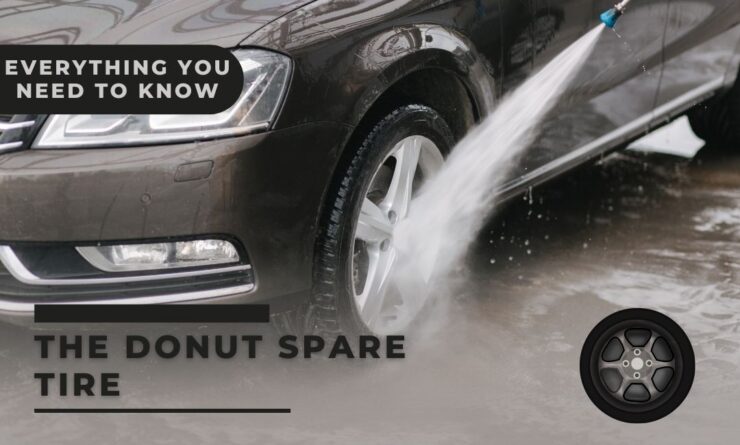Having a spare tire is more than just an accessory for drivers; it is a crucial safety measure that provides security and peace of mind in case of emergencies or surprises on the road. When unexpected flat tires occur due to nails, glass shards, or potholes, a spare tire allows drivers to quickly swap it out and continue their journey without the need for costly roadside assistance. Moreover, having a functional spare tire becomes particularly vital during long-distance trips when it may not be easy to access auto repair help. It provides drivers with independence, allowing them to handle minor problems without relying on external aid.
Different Types of Spare Tires
There are two main types of spare tires available: full-size and donut spare tires. The donut spare tire, also known as a compact tire, is designed specifically for emergencies and temporary use. It is smaller and lighter than regular tires, making it easier to store in the vehicle’s trunk or undercarriage. These donut spares are constructed using lightweight materials, such as reinforced rubber and steel belts, which facilitate easy handling and installation during emergencies. However, it’s important to note that donut spare tires have some limitations and are not suitable for extended use or high-speed driving.
Understanding Donut Spare Tires
The key features that set donut spare tires apart from full-size tires are their compact size, lightweight construction, and limited range and speed. Due to their smaller size, they are intended for temporary use only and should not be driven for extended distances or at high speeds. Additionally, the use of donut spares may affect vehicle handling and stability, requiring drivers to exercise caution and adjust their driving accordingly.
Tips for Safe and Effective Use
To ensure optimal safety and effectiveness when using donut spare tires, drivers should follow these guidelines:
- Drive with Caution: Recognize that donut spare tires can alter vehicle handling, so drive at a reduced speed and maintain a safe distance from other vehicles.
- Limited Distance Travel: Donut spares are meant for temporary use only, so do not exceed the recommended mileage with them.
- Regular Maintenance: Regularly inspect all tires, including the spare, for signs of damage or wear. Proper maintenance keeps the spare tire in good condition and ready to use during emergencies.
Benefits of Using Donut Spare Tires
Despite their limitations, donut spare tires offer several benefits, such as easy installation and portability. In the event of a flat tire, the process of replacing it with a donut spare is straightforward and can be done quickly, saving valuable time and effort.
Limitations
While donut spare tires are practical for emergencies, they do come with limitations. Reduced speed and limited distance capabilities, as well as decreased traction and handling, make them less suitable for long-distance travel. Drivers should be aware that donut spares are intended as temporary solutions and should not be used as long-term replacements for regular tires.
Proper Maintenance and Care
To ensure the effectiveness and longevity of a donut spare tire, drivers should adhere to proper maintenance and care practices, such as:
- Regularly Check Air Pressure: Ensure the spare tire is properly inflated, as low air pressure can compromise its performance in an emergency.
- Monitor Tread Depth: Pay attention to the tread depth, as worn tread may not provide sufficient grip, compromising safety.
- Store Correctly: Store the spare tire in a clean, dry area away from direct sunlight and extreme temperatures to prevent deterioration.
- Inspect for Damage: Regularly inspect the spare tire for cuts, bulges, or punctures, and promptly address any issues to maintain its functionality.
- Rotate Regularly: During routine maintenance intervals, rotate the donut spare tire to ensure even wear.
Conclusion
Having a spare tire is an essential aspect of responsible driving, providing drivers with security, independence, and convenience during unexpected tire emergencies. Understanding the types of spare tires available, specifically the practicality and limitations of donut spare tires, empowers drivers to make informed decisions and ensures their safety on the road. By following maintenance guidelines and handling instructions, drivers can maximize the benefits of their donut spare tires, making every journey a safer and more enjoyable experience. Remember, a well-maintained spare tire is a reliable companion that ensures you’re prepared for any road mishaps that come your way!
FAQs
What is a donut spare tire?
A donut tire, also known as a temporary spare, is a smaller-sized spare that is intended for temporary use until a regular full-sized can be installed.
How long can it be used for?
It is designed to be used for a short period of time, typically no more than 50-70 miles. The tire is not intended for long-term use and should be replaced as soon as possible.
Can a donut spare tire be driven on the highway?
While it is possible to drive on the highway with a donut spare tire, it is generally not recommended. It is not as durable as a regular tire and is not designed for high-speed or long-distance driving.
Does every car come with a donut spare tire?
No, not every car comes with a donut spare tire. Some cars may come with a full-sized spare or a repair kit instead.
How do I know if my car has one?
You can check your car’s owner manual to see if it comes with a donut spare tire. Alternatively, you can look in your car’s trunk or under the vehicle to see if there is a spare tire present.
Can a spare tire be repaired?
It is generally not recommended to repair a donut spare. It is not as durable as a regular tire and may not be safe to use after being repaired.
Final Words
In conclusion, a well-maintained donut spare is vital for keeping you on the road in an emergency. Prepare your vehicle’s emergency kit so you can confidently address potential tire problems. Don’t let a flat tire leave you stranded—take care of your donut, and drive with peace of mind.



















